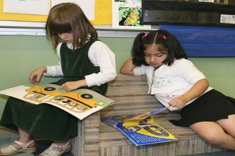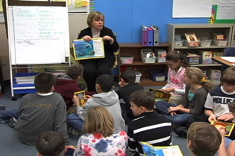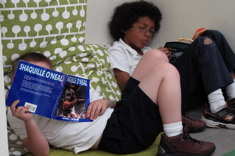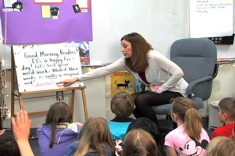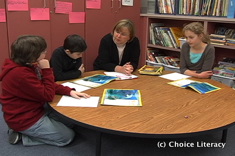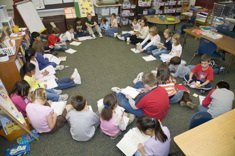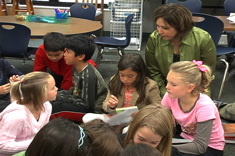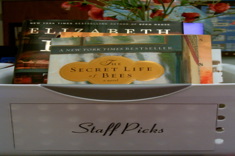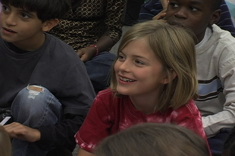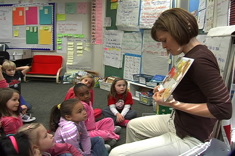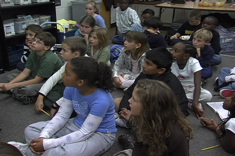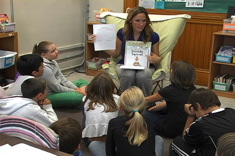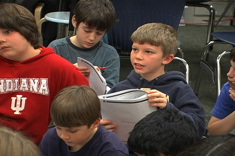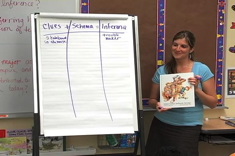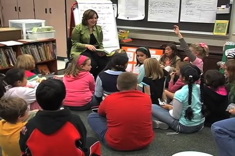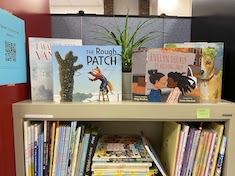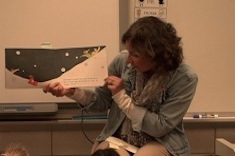Mentor Texts
It's all about the right book at the right time, given to the right student or used in the right lesson . . . Here is where we gather all those suggestions from our contributors for using mentor texts, including lesson protocols and scores of video examples.
Latest Content
Choosing New Books for Comprehension Strategy Studies with Young Children
Ruth Shagoury and Andie Cunningham share a wealth of books appropriate for comprehension study with young children. The booklist is especially useful for work with English language learners.
Thinking About 5th Grade Read Alouds
Karen Terlecky develops a plan for read alouds with her 5th grade students. She explains her choices, comparing selections to last year's list.
Biographies Off the Beaten Path
Here are some quirky biographies that will inspire and delight your students.
Punctuation Study with Third Graders
Mandy Robek finds a punctuation unit study with her third graders is a fun alternative to yet another genre study. Her essay includes booklists of children's literature and professional texts.
Using Mentor Texts in Study Groups: Play and Practice
Jennifer Allen considers ways to be more practical and playful in introducing mentor texts during study groups with colleagues.
Planning to Teach with Mentor Texts: Two Examples
Once you’ve found a text you love, how do you plan lessons from it? Karen Terlecky takes teachers through the process of selecting and designing instruction with two favorite texts.
Reflections on Our Year of Read Alouds (BOOKLIST)
if you're moving from thinking about read alouds for the first days of school, to plotting out a plan for read alouds all year long, you might want to read Franki Sibberson's booklist of read-alouds used for the entire year with her 3rd and 4th grade students.
Literary Nonfiction: Models for Writing
Literary nonfiction is emerging as a popular genre. In this booklist, Franki Sibberson shares mentor texts for writing literary nonfiction.
Helping Struggling Writers
How can we help students who are stuck when it comes time to write? Franki Sibberson shares a couple new strategies, including a book basket of texts selected by students themselves as useful for sparking writing topics in this photo essay.
Helping Students Find Their Own Mentor Texts
Franki Sibberson helps her students learn how to evaluation and discover their own mentor texts in her grades 3 and 4 literacy workshops.
The Books We Can’t Live Without in Our Teaching: Resource Round-Up
Literacy experts share their well-loved and well-worn children's and professional books.
Old Elm Speaks: Connecting Poetry, Observation, and Reading
In this first installment of a three-part video series, Aimee Buckner shows how observation skills, poetry, and reading instruction come together with the mentor text Old Elm Speaks by Kristin O’Connell George.
Picture Reading in First Grade
In this read-aloud lesson from Katie DiCesare's first-grade classroom, Katie demonstrates the importance of picture reading using the wordless picture book The Zoo by Suzy Lee.
From Questions to Drafts
Aimee Buckner shares the mentor text Could You? Would You? with her 4th grade students. Aimee explains how questions are a springboard to interesting writing topics, and models connections she makes to the text.
Writing Comics: Introducing the Activity
In this lesson from a fourth-grade classroom, Sarah Thibault introduces students to a writing activity. Students will be creating their own comic books, after extensive preparation and experience with mentor texts.
Talking About Tests
Franki Sibberson prepares her grades 3-4 students for state examinations by helping them observe attributes and patterns in test questions.
Inferring Read Aloud Part I
Katie Doherty demonstrates how she uses picture books to teach inferring strategies to her sixth graders in this video series. Part I is a presentation of the book to students.
Crafting Characters in Writer’s Workshop
If you are looking for a “peppery” heroine, Mary from The Secret Garden is one for the ages. In this video of a lesson in writer’s workshop, Franki Sibberson shows how shared text can be used to help young writers understand character traits and development.
Narrative Nonfiction in Fifth Grade, Part 1
In this lesson from a fifth-grade classroom, Aimee Buckner guides students in a notetaking process to help them understand the qualities of nonfiction narrative writing.
Building Community Access to Texts Through a Lending Library
Tara Barnett and Kate Mills share the way a lending library can provide an additional resource for teachers and community members to quickly get the books they need. They offer practical steps to make the lending library a go-to resource as well as a template to track the monthly book highlights.
Inside and Outside Views Minilesson
Ruth Ayres leads a minilesson in second grade on inside/outside views — what’s happening objectively (on the outside) vs. emotions (on the inside). The terms are a good starting point for helping young students distinguish between facts and opinions.
Browse Content By
Type
Category
- Assessment Tools
- Big Fresh Archives
- Booklists
- Choice Numeracy
- Classroom Design
- Common Core
- Community Building
- Conferring
- Content Literacy
- Digital Literacy
- English Language Learners
- Equity
- Family Relations
- Free Samples
- Guiding Groups
- Leadership
- Literacy Coaches
- Mentor Texts
- Minilessons
- New Teacher Mentors
- Podcasts
- Poetry
- Quote Collections
- Reading Strategies
- Self Care
- Struggling and Striving Learners
- Talking and Listening
- Teacher Study Groups
- Teaching Reading
- Teaching Writing
- Word Study and Vocabulary
Author
- Melissa Quimby
- Nawal Qarooni
- Gwen Blumberg
- Julie Cox
- The Lead Learners
- Hannah Tills
- Josie Stewart
- Ruth Metcalfe
- Mallory Messenger
- Becca Burk
- Jodie Bailey
- Vivian Chen
- Mary Brower
- Tiffany Abbott Fuller
- Stephanie Affinito
- Ruth Ayres
- Leigh Anne Eck
- Heather Fisher
- Shari Frost
- Julie Johnson
- Suzy Kaback
- Gigi McAllister
- Shirl McPhillips
- Melanie Meehan
- Cathy Mere
- Debbie Miller
- Tara Barnett and Kate Mills
- Tammy Mulligan
- Dana Murphy
- Bitsy Parks
- David Pittman
- Brenda Power
- Heather Rader
- Matt Renwick
- Mandy Robek
- Christy Rush-Levine
- Gretchen Schroeder
- Jen Schwanke
- Brian Sepe
- Katherine Sokolowski
- Stella Villalba
- Jennifer Vincent
Grade Level
Choice Literacy Membership
Articles
Get full access to all Choice Literacy article content
Videos
Get full access to all Choice Literacy video content
Courses
Access Choice Literacy course curriculum and training

